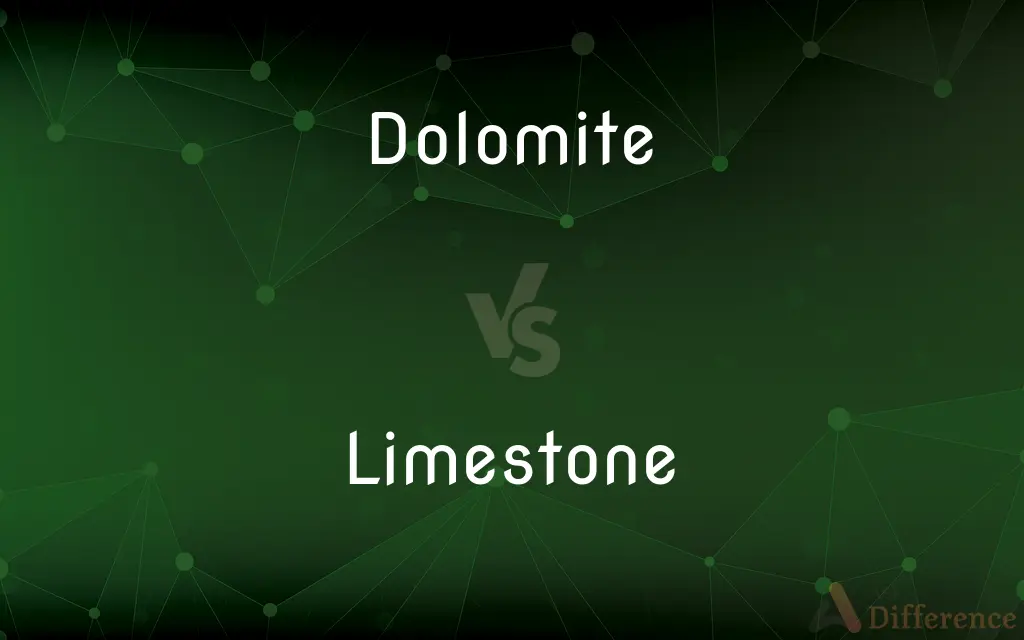Dolomite vs. Limestone — What's the Difference?
By Tayyaba Rehman & Maham Liaqat — Updated on March 16, 2024
Dolomite and limestone are both carbonate rocks, with dolomite containing calcium magnesium carbonate while limestone is primarily calcium carbonate.

Difference Between Dolomite and Limestone
Table of Contents
ADVERTISEMENT
Key Differences
Dolomite, a mineral composed of calcium magnesium carbonate (CaMg(CO3)2), differs from limestone, which is predominantly calcium carbonate (CaCO3). Dolomite forms in a variety of sedimentary settings, often associated with magnesium-rich fluids, while limestone is more commonly found in shallow marine environments, where organisms such as corals, algae, and shellfish contribute to its formation.
Dolomite often contains impurities like silica, iron, and aluminum, whereas limestone's purity varies, with high-calcium limestone being almost pure calcium carbonate. This variation in composition affects their respective uses; dolomite is prized in the agricultural and construction sectors for its magnesium content, while limestone is widely used in the construction industry, particularly for cement and as crushed stone.
In terms of appearance, dolomite can exhibit a range of colors including white, pink, gray, or tan, influenced by its mineral impurities. Limestone, on the other hand, is typically white to gray in color, but can also display shades of brown, yellow, or black, depending on the presence of organic matter or impurities.
Dolomite's structure differs from that of limestone due to the presence of magnesium, which leads to a slightly different crystalline structure. This structural difference gives dolomite a slightly greater hardness and a more crumbly texture compared to the often smoother texture of limestone.
Finally, dolomite reacts slowly with acid, producing a weak, effervescent bubbling, whereas limestone reacts more vigorously, producing more pronounced fizzing. This reaction difference is a key identifier in distinguishing between the two rocks in the field.
ADVERTISEMENT
Comparison Chart
Composition
Calcium magnesium carbonate (CaMg(CO3)2)
Calcium carbonate (CaCO3)
Formation
Forms in the presence of magnesium-rich fluids
Formed from shell, coral, algal, and fecal debris
Uses
Construction, agriculture (soil conditioner)
Cement production, construction, soil conditioner
Appearance
White, pink, gray, tan, depending on impurities
Often white or gray, can be colored by impurities
Reaction with Acid
Slow, weak effervescence
Vigorous fizzing
Compare with Definitions
Dolomite
A mineral consisting of calcium magnesium carbonate, often used as a soil conditioner.
The soil analysis recommended adding dolomite to adjust its pH balance.
Limestone
A sedimentary rock mainly composed of calcium carbonate, often formed from coral or shell debris.
The ancient city was built with locally sourced limestone.
Dolomite
Dolomite can refer to the dolomitic limestone, which contains some dolomite along with limestone.
Dolomite in the garden improves soil aeration and water retention.
Limestone
A form of limestone, chalk, is used in various applications from education to agriculture.
The farmer used finely ground limestone to neutralize the acidic soil.
Dolomite
In geology, dolomite can also refer to a geological formation known for its distinctive sedimentary rocks.
The Dolomite mountains are renowned for their stunning landscapes.
Limestone
Limestone caves, formed by water eroding the rock over millions of years, are tourist attractions.
The limestone cave system is home to rare bat species and stunning stalactites.
Dolomite
A sedimentary rock composed primarily of the mineral dolomite.
The quarry specializes in extracting dolomite for construction materials.
Limestone
Limestone is widely used in the construction industry, especially in cement production.
The new highway project will require thousands of tons of crushed limestone.
Dolomite
Dolomite serves as a source of magnesium oxide in industrial applications.
Dolomite is calcined to produce magnesium for various industrial uses.
Limestone
Limestone's chemical reactivity makes it useful in industrial processes such as the production of lime.
The chemical plant sources limestone as a raw material for lime production.
Dolomite
A white or light-colored mineral, essentially CaMg(CO3)2, used in fertilizer, as a furnace refractory, and as a construction and ceramic material.
Limestone
Limestone is a common type of carbonate sedimentary rock. It is composed mostly of the minerals calcite and aragonite, which are different crystal forms of calcium carbonate (CaCO3).
Dolomite
A magnesia-rich sedimentary rock resembling limestone.
Limestone
A common sedimentary rock consisting mostly of calcium carbonate, CaCO3, used as a building stone and in the manufacture of lime, carbon dioxide, and cement.
Dolomite
(mineral) An evaporite consisting of a mixed calcium and magnesium carbonate, with the chemical formula CaMg(CO3)2; it also exists as the rock dolostone.
Limestone
An abundant rock of marine and fresh-water sediments; primarily composed of calcite (CaCO3); it occurs in a variety of forms, both crystalline and amorphous.
Dolomite
A mineral consisting of the carbonate of lime and magnesia in varying proportions. It occurs in distinct crystals, and in extensive beds as a compact limestone, often crystalline granular, either white or clouded. It includes much of the common white marble. Also called bitter spar.
Limestone
Pertaining to or made of limestone.
Dolomite
A kind of sedimentary rock resembling limestone but consisting almost entirely of the mineral dolomite
Limestone
A rock consisting chiefly of calcium carbonate or carbonate of lime. It sometimes contains also magnesium carbonate, and is then called magnesian or dolomitic limestone. Crystalline limestone is called marble.
Dolomite
A light colored mineral consisting of calcium magnesium carbonate; a source of magnesium; used as a ceramic and as fertilizer
Limestone
A sedimentary rock consisting mainly of calcium that was deposited by the remains of marine animals
Common Curiosities
Are dolomite and limestone found in the same environments?
They can be, but dolomite often forms in environments with magnesium-rich fluids, while limestone is typically marine.
Can dolomite be used in construction like limestone?
Yes, dolomite can be used in construction, particularly where magnesium content is beneficial.
Is dolomite harder than limestone?
Yes, the presence of magnesium makes dolomite slightly harder.
Can limestone and dolomite be used interchangeably in agriculture?
They can both be used to condition soil, but dolomite also adds magnesium.
What is the significance of the Dolomite mountains?
Named for the mineral dolomite, they are known for their geological and scenic value.
What is the main chemical difference between dolomite and limestone?
Dolomite contains calcium magnesium carbonate, whereas limestone is mostly calcium carbonate.
How do dolomite and limestone react with acid?
Dolomite reacts slowly with weak effervescence, while limestone reacts vigorously.
Can dolomite and limestone be found in all parts of the world?
Yes, both rocks are widespread and found in many geological settings.
How are dolomite and limestone used in the production of lime?
Both can be calcined to produce lime, but the process and end products differ slightly due to their chemical compositions.
What are the common uses of limestone?
Limestone is used in cement production, construction, and as a soil conditioner.
Do both rocks form in similar time periods?
They can, but this depends on specific geological and environmental conditions.
How does the color of dolomite compare to that of limestone?
Dolomite can be white, pink, gray, or tan, while limestone is often white or gray but can have other colors due to impurities.
What role does dolomite play in the agricultural sector?
It is used as a soil conditioner and a source of magnesium for plants.
Are dolomite and limestone affected by weathering in the same way?
Both are susceptible to weathering, but dolomite is slightly more resistant due to its magnesium content.
How do the textures of dolomite and limestone differ?
Dolomite tends to have a more crumbly texture, while limestone is often smoother.
Share Your Discovery

Previous Comparison
Spear vs. Polearm
Next Comparison
Chilopoda vs. DiplopodaAuthor Spotlight
Written by
Tayyaba RehmanTayyaba Rehman is a distinguished writer, currently serving as a primary contributor to askdifference.com. As a researcher in semantics and etymology, Tayyaba's passion for the complexity of languages and their distinctions has found a perfect home on the platform. Tayyaba delves into the intricacies of language, distinguishing between commonly confused words and phrases, thereby providing clarity for readers worldwide.
Co-written by
Maham Liaqat













































